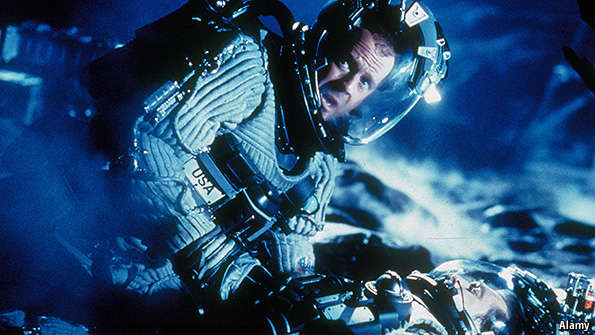Catastrophes that could end the world
The Economist
20 أبريل 2015

THE eruption of Tambora 200 years ago was the largest volcanic blast of modern history, killing something like 100,000 people in what is today Indonesia, producing an ash cloud that covered a million square kilometres and temporarily changing the global climate. The veil of sulphate particles which Tambora created in the stratosphere cooled the planet’s continents by an average of about 2ºC in the following year; local changes were in some places much more severe, and there was agricultural chaos in North America, Europe and China. Volcanoes are nasty; other natural disasters—such as storms, floods and earthquakes—only have global effects because of the interconnectedness of human societies and economies, while large eruptions have direct geophysical effects worldwide. Yet volcanoes are not the only existential threats humanity faces. Which catastrophes could actually end human civilisation?
A repeat of Tambora would have similar climatic effects, though it is possible that in today’s world their human impact would not be so severe. But the next large eruption could be a lot bigger than that. In terms of the volume of rock the eruption of the volcanic caldera at Taupo, in New Zealand, 26,500 years ago, was well over ten times the size of Tambora; that of Toba, in Indonesia, 75,000 years ago was almost 100 times larger than the 1815 blast. The area covered by ash from Toba to a depth of a centimetre or more has a population of about 2 billion people today. The climatic effects of an eruption do not increase linearly with its size, but if it arrived without years of warning (time to allow massive precautionary stockpiling) a repeat of the Toba eruption today would be a devastating blow to food security on a global scale and could be expected to cause tens of millions or hundreds of millions of casualties. Some researchers believe that the Toba eruption was sufficiently devastating to Homo sapiens, which may well then have been found at that time only in east Africa, as to almost wipe the species out. That could explain why modern humans have a very low level of genetic diversity compared with other apes.
Advertisement
The only other natural disasters of similar consequence are impacts by asteroids and comets, which can massively disrupt the climate in similar ways. The impact of an asteroid 1km-2km across is expected roughly once every million years or so, and some estimate that its effects could be severe enough to bring death to hundreds of millions or billions. There are also larger impacts; the one that occurred in what is now the Yucatan at the end of the Cretaceous period, 66m years ago, was probably 10km or more across. That impact is widely thought to have brought with it a mass extinction which killed off well over half the species on the planet. The good thing about asteroid impacts is that they are both rare and avoidable. Although humans can change the climate themselves—and the changes they are currently bringing about look likely to have have much larger long-term effects on the climate and other aspects of the Earth, such as its ocean chemistry, than even an eruption as large as Toba’s did—there is no currently imaginable way for people to stop a major volcanic eruption. But in the highly unlikely event that a 1km asteroid discovered tomorrow was shown to have a high probability of hitting the Earth on some day towards the middle or end of this century then it is quite plausible to assume that its orbit could and would be altered in the intervening decades (decades of warning are much more likely, in this case, than just a few years). Blowing the offending object apart with nuclear weapons, as favoured by Bruce Willis and other heroes of the silver screen, would probably be a bad idea. But using such blasts to nudge it onto an Earth-missing trajectory could make a lot of sense if there was not enough time to develop more precise and easily controlled approaches to the problem.
This is not a reason to rejoice in the availability of nuclear weapons, though. It is hard not to think that they represent a far more likely cause of global disruption on a civilisation-ending scale than either supervolcanoes or asteroids. The direct casualties in an all-out nuclear war would in all likelihood greatly outnumber those of a supervolcano eruption, and such a war might easily have climate effects that were just as bad or even worse. And if the chances of a nuclear war in any given year are as little as 10,000 to one, that would still mean a better than even chance of seeing one in the next 7,000 years—far sooner than the time you would expect to wait for a Toba-scale eruption, let alone a world-altering asteroid impact.
 عن أمل جنبلاط المتجدد: لبنان يستحق النضال
عن أمل جنبلاط المتجدد: لبنان يستحق النضال
 صحافيون أم عرّافون!
صحافيون أم عرّافون!
 ماذا يجري داخل أروقة بيت الكتائب المركزي؟
ماذا يجري داخل أروقة بيت الكتائب المركزي؟


 عن الخرائط التي تُرسم والإتفاقات التي تتساقط!
عن الخرائط التي تُرسم والإتفاقات التي تتساقط!
 “الإنحراف في الحياة”/ بقلم كمال جنبلاط
“الإنحراف في الحياة”/ بقلم كمال جنبلاط
 هاشتاغ #صار_الوقت يحل أولاً في حلقة جنبلاط
هاشتاغ #صار_الوقت يحل أولاً في حلقة جنبلاط
 طاولة نقاش عن أزمة الصحافة في جامعة AUST
طاولة نقاش عن أزمة الصحافة في جامعة AUST
 عبدالله: ليظهر لنا وزير مكافحة الفساد حرصه في صفقات البواخر والفيول
عبدالله: ليظهر لنا وزير مكافحة الفساد حرصه في صفقات البواخر والفيول
 عبدالله: غريب أمر وزارة مكافحة الفساد!
عبدالله: غريب أمر وزارة مكافحة الفساد!

 Comment to Uri Avnery: How Sad What Is Looming Ahead
Comment to Uri Avnery: How Sad What Is Looming Ahead
 “Not Enough!”
“Not Enough!”
 … لمن لم يقرأ يوسف البعيني/ بقلم وسام شيّا
… لمن لم يقرأ يوسف البعيني/ بقلم وسام شيّا
 كمال جنبلاط في مولده الأول بعد المائة: تعاليمه وأفكاره ما زالت الحلّ/بقلم عزيز المتني
كمال جنبلاط في مولده الأول بعد المائة: تعاليمه وأفكاره ما زالت الحلّ/بقلم عزيز المتني
 رئيس حزب/ وليس (… سابقاً)/ بقلم د. خليل احمد خليل
رئيس حزب/ وليس (… سابقاً)/ بقلم د. خليل احمد خليل
 التوازن السياسي في لبنان
التوازن السياسي في لبنان
 لبنان… مشاريع انقلابية مؤجلة
لبنان… مشاريع انقلابية مؤجلة
 جنبلاط وحَمَلة أختام الكاوتشوك
جنبلاط وحَمَلة أختام الكاوتشوك
 Le Liban est un symbole de tolérance
Le Liban est un symbole de tolérance
 Our Automated Future
Our Automated Future
 The True Origins of ISIS
The True Origins of ISIS
 Les Misérables vs. Macron
Les Misérables vs. Macron
 عذراً أيها المعلم/ بقلم مهج شعبان
عذراً أيها المعلم/ بقلم مهج شعبان
 رساله الى المعلم / بقلم ابو عاصم
رساله الى المعلم / بقلم ابو عاصم
 إلى روح القائد والمعلم كمال جنبلاط/ بقلم أنور الدبيسي
إلى روح القائد والمعلم كمال جنبلاط/ بقلم أنور الدبيسي
 أسرار وعناوين الصحف ليوم الجمعة 14 كانون الاول 2018
أسرار وعناوين الصحف ليوم الجمعة 14 كانون الاول 2018














